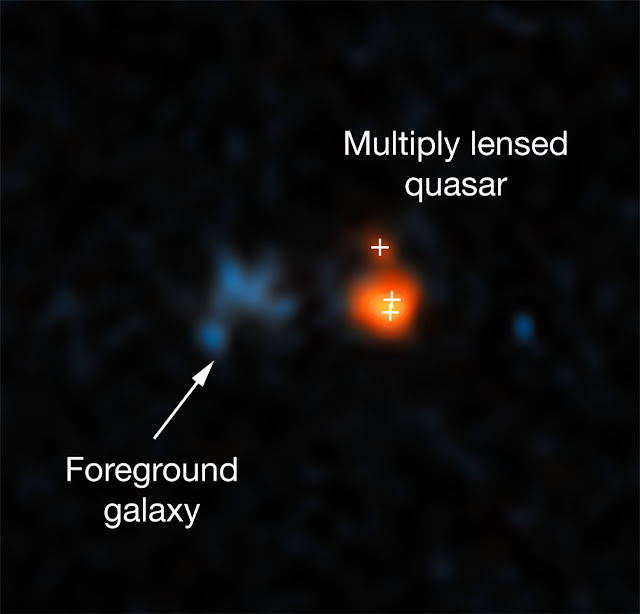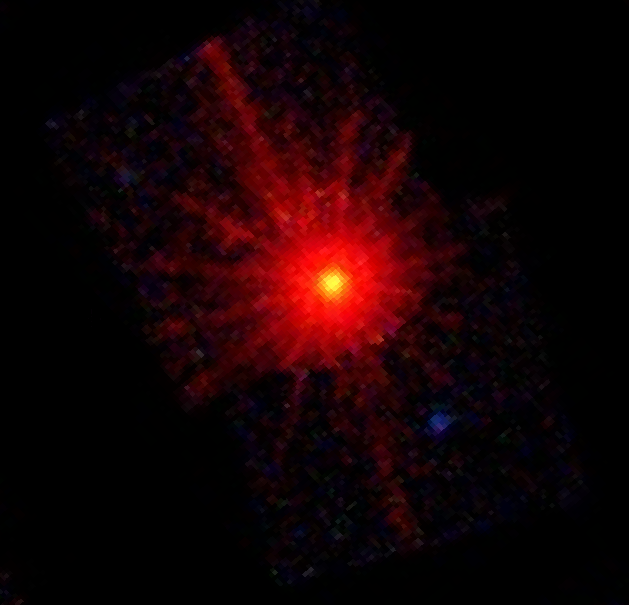NASA logo.
January 12, 2019
Image above: The supermoon lunar eclipse captured as it moved over NASA’s Glenn Research Center on September 27, 2015. Image Credits: NASA/Rami Daud.
In the News
Looking up at the Moon can create a sense of awe at any time, but those who do so on the evening of January 20 will be treated to the only total lunar eclipse of 2019. Visible for its entirety in North and South America, this eclipse is being referred to by some as a super blood moon – “super” because the Moon will be closest to Earth in its orbit during the full moon (more on supermoons here) and “blood" because the total lunar eclipse will turn the Moon a reddish hue (more on that below). This is a great opportunity for students to observe the Moon – and for teachers to make connections to in-class science content.
How It Works
Eclipses can occur when the Sun, the Moon and Earth align. Lunar eclipses can happen only during a full moon, when the Moon and the Sun are on opposite sides of Earth. At that point, the Moon can move into the shadow cast by Earth, resulting in a lunar eclipse. However, most of the time, the Moon’s slightly tilted orbit brings it above or below Earth’s shadow.
Understanding Lunar Eclipses
The time period when the Moon, Earth and the Sun are lined up and on the same plane – allowing for the Moon to pass through Earth’s shadow – is called an eclipse season. Eclipse seasons last about 34 days and occur just shy of every six months. When a full moon occurs during an eclipse season, the Moon travels through Earth’s shadow, creating a lunar eclipse.
Image above: When a full moon occurs during an eclipse season, the Moon travels through Earth's shadow, creating a lunar eclipse. Image Credits: NASA/JPL-Caltech.
Unlike solar eclipses, which require special glasses to view and can be seen only for a few short minutes in a very limited area, a total lunar eclipse can be seen for about an hour by anyone on the nighttime side of Earth – as long as skies are clear.
The Moon passes through two distinct parts of Earth’s shadow during a lunar eclipse. The outer part of the cone-shaped shadow is called the penumbra. The penumbra is less dark than the inner part of the shadow because it’s penetrated by some sunlight. (You have probably noticed that some shadows on the ground are darker than others, depending on how much outside light enters the shadow; the same is true for the outer part of Earth’s shadow.) The inner part of the shadow, known as the umbra, is much darker because Earth blocks additional sunlight from entering the umbra.
At 0:36 GMT (6:36 p.m. PST 9:36 p.m. EST) on January 20, the edge of the Moon will begin entering the penumbra. The Moon will dim very slightly for the next 57 minutes as it moves deeper into the penumbra. Because this part of Earth’s shadow is not fully dark, you may notice only some dim shading (if anything at all) on the Moon near the end of this part of the eclipse.
Image above: During a total lunar eclipse, the Moon first enters into the penumbra, or the outer part of Earth's shadow, where the shadow is still penetrated by some sunlight. Image Credit: NASA.
At 1:33 GMT (7:33 p.m. PST 10:33 p.m. EST), the edge of the Moon will begin entering the umbra. As the Moon moves into the darker shadow, significant darkening of the Moon will be noticeable. Some say that during this part of the eclipse, the Moon looks as if it has had a bite taken out of it. That “bite” gets bigger and bigger as the Moon moves deeper into the shadow.
Image above: As the Moon starts to enter into the umbra, the inner and darker part of Earth's shadow, it appears as if a bite has been taken out of the Moon. This "bite" will grow until the Moon has entered fully into the umbra. Image Credit: NASA.
At 2:41 GMT (8:41 p.m. PST 11:41 p.m. EST), the Moon will be completely inside the umbra, marking the beginning of the total lunar eclipse. The moment of greatest eclipse, when the Moon is halfway through the umbra, occurs at 3:12 GMT (9:12 p.m. PST 12:12 a.m. EST).
Image above: The total lunar eclipse starts once the moon is completely inside the umbra. And the moment of greatest eclipse happens with the Moon is halfway through the umbra as shown in this graphic. Image Credit: NASA.
As the Moon moves completely into the umbra, something interesting happens: The Moon begins to turn reddish-orange. The reason for this phenomenon? Earth’s atmosphere. As sunlight passes through it, the small molecules that make up our atmosphere scatter blue light, which is why the sky appears blue. This leaves behind mostly red light that bends, or refracts, into Earth’s shadow. We can see the red light during an eclipse as it falls onto the Moon in Earth’s shadow. This same effect is what gives sunrises and sunsets a reddish-orange color.
Image above: As the Moon moves completely into the umbra, it turns a reddish-orange color. Image Credit: NASA.
A variety of factors affect the appearance of the Moon during a total lunar eclipse. Clouds, dust, ash, photochemical droplets and organic material in the atmosphere can change how much light is refracted into the umbra. Additionally, the January 2019 lunar eclipse takes place when the full moon is at or near the closest point in its orbit to Earth – a time popularly known as a supermoon. This means the Moon is deeper inside the umbra shadow and therefore may appear darker. The potential for variation provides a great opportunity for students to observe and classify the lunar eclipse based on its brightness. Details can be found in the “Teach It” section below.
At 3:43 GMT (9:43 p.m. PST 12:43 a.m. EST), the edge of the Moon will begin exiting the umbra and moving into the opposite side of the penumbra. This marks the end of the total lunar eclipse.
At 4:50 GMT (10:50 p.m. PST 1:50 a.m. EST), the Moon will be completely outside the umbra. It will continue moving out of the penumbra until the eclipse ends at 5:48 GMT (11:48 p.m 2:48 a.m. EST).
What if it’s cloudy where you live? Winter eclipses always bring with them the risk of poor viewing conditions. If your view of the Moon is obscured by the weather, explore options for watching the eclipse online, such as the Time and Date live stream: https://www.timeanddate.com/live/
Lunar eclipses have long played an important role in understanding Earth and its motions in space.
Total Lunar Eclipse. Animation Credits: NASA/JPL
In ancient Greece, Aristotle noted that the shadows on the Moon during lunar eclipses were round, regardless of where an observer saw them. He realized that only if Earth were a spheroid would its shadows be round – a revelation that he and others had many centuries before the first ships sailed around the world.
Earth wobbles on its axis like a spinning top that’s about to fall over, a phenomenon called precession. Earth completes one wobble, or precession cycle, over the course of 26,000 years. Greek astronomer Hipparchus made this discovery by comparing the position of stars relative to the Sun during a lunar eclipse to those recorded hundreds of years earlier. A lunar eclipse allowed him to see the stars and know exactly where the Sun was for comparison – directly opposite the Moon. If Earth didn’t wobble, the stars would appear to be in the same place they were hundreds of years earlier. When Hipparchus saw that the stars’ positions had indeed moved, he knew that Earth must wobble on its axis!
Lunar eclipses are also used for modern-day science investigations. Astronomers have used ancient eclipse records and compared them with computer simulations. These comparisons helped scientists determine the rate at which Earth’s rotation is slowing.
More on supermoons here: https://www.jpl.nasa.gov/edu/news/2017/11/15/whats-a-supermoon-and-just-how-super-is-it/
Images (mentioned), Animation (mentioned), Video, Text, Credits: NASA/Goddard/JPL/Lyle Tavernier.
Greetings, Orbiter.ch
















































